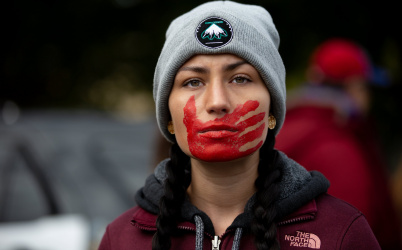In the heartland of Native American reserves, a harrowing crisis has unfolded that demands urgent attention – the staggering number of missing and murdered Indigenous women. For far too long, their disappearances have gone unnoticed and their stories untold. As a new reporter specializing in Native affairs, it is imperative to shed light on this issue, while also addressing the underlying systemic issues of institutional racism and historical denial that perpetuate the genocide on Native Americans.
- The Disturbing Statistics:
The extent of the crisis becomes alarmingly clear when examining the statistics. According to the Indian Law Resource Center, Native American women are 2.5 times more likely to experience violence in their lifetime compared to other groups. Additionally, the National Crime Information Center reported over 5,000 cases of missing Native American women in 2019, although the actual number could be significantly higher due to underreporting and inconsistent data collection methods. These numbers are indicative of the deep-rooted issues Native American communities face.
Source 1: “Violence Against Indigenous Women” – Indian Law Resource Center (https://www.indianlaw.org/violence-against-indigenous-women/)
- Institutional Racism and Historical Denial:
The crisis of missing Indigenous women cannot be divorced from the broader context of institutional racism and historical denial that has plagued Native American communities for centuries. From the forced removal of Indigenous peoples from their lands to the assimilation policies of the boarding schools, the legacy of colonialism has deeply affected the social, economic, and political structures within which Native Americans live. The unwillingness of American institutions to recognize and reckon with this genocide has perpetuated a system of marginalization and erasure.
Source 2: “Recognizing and Acknowledging the Genocide of Native Americans” – American Indian Law Review (https://digitalcommons.law.ou.edu/ailr/vol41/iss2/3/)
- Systemic Failures and Institutional Bias:
Within the criminal justice system, systemic failures and institutional biases further compound the crisis of missing Indigenous women. Cases are often mishandled or ignored, and law enforcement responses can be inadequate or insensitive. This lack of action and accountability reflects deep-seated biases against Native Americans, leading to a sense of injustice and despair among the affected communities. Addressing these systemic failures requires a comprehensive examination of policies, training, and cultural competency within law enforcement agencies.
Source 3: “Missing and Murdered Indigenous Women and Girls: A Report to Congress” – United States Commission on Civil Rights (https://www.usccr.gov/pubs/2018/11-15-Missing-and-Murdered-Indigenous-Women-Girls.pdf)
- Grassroots Movements and Advocacy:
Amidst this ongoing crisis, grassroots movements and Indigenous-led organizations have emerged to challenge institutional racism and demand justice. The #MMIWG movement, led by Native American activists and allies, has successfully raised awareness, advocated for policy reforms, and provided support networks for survivors and families. Their tireless efforts are instrumental in pressuring institutions to address the crisis, acknowledge historical genocide, and work towards creating safer and more equitable communities for Indigenous women.
Source 4: “The Red Ribbon Dress: A Symbol of Resilience and a Call to Action” – Native Women’s Association of Canada (https://www.nwac.ca/the-red-ribbon-dress-a-symbol-of-resilience-and-a-call-to-action/)
:
The plight of missing women in Native American reserves is not only a crisis in itself but also indicative of the larger systemic issues of institutional racism and historical denial. It is essential to understand the deep-rooted factors that contribute to this crisis, including the ongoing genocide against Native Americans. By acknowledging the distressing statistics, addressing institutional racism, and supporting grassroots movements, we can work towards systemic change, improved data collection, and the recognition and protection of the rights of Indigenous women. Through responsible reporting, raising public awareness, and holding institutions accountable, we can strive for a future where Native women are valued, protected, and their voices are heard.
There are several organizations in the Pacific Northwest that are actively working on addressing the issue of missing and murdered Indigenous women. Here are a few prominent organizations in the region:
- Coalition to Stop Violence Against Native Women (CSVANW): Based in New Mexico, CSVANW works with tribal communities throughout the Pacific Northwest and provides resources, advocacy, and training to address violence against Native women and support survivors.
Website: https://www.csvanw.org/
- National Indigenous Women’s Resource Center (NIWRC): NIWRC is a national organization that provides training, technical assistance, and resources to tribes and Native organizations across the country. They focus on addressing violence against Native women and advocating for policy changes.
Website: https://www.niwrc.org/
- Urban Native Youth Association (UNYA): Located in Vancouver, British Columbia, UNYA works with Indigenous youth in the Pacific Northwest, providing support services, cultural programs, and advocacy to address issues such as violence, homelessness, and missing Indigenous women.
Website: https://unya.bc.ca/
- Missing and Murdered Indigenous Women Washington (MMIW WA): MMIW WA is a grassroots organization in Washington State dedicated to raising awareness about missing and murdered Indigenous women and advocating for justice. They engage in community organizing, events, and advocacy efforts.
Website: https://mmiw-wa.org/
- Washington State Coalition Against Domestic Violence (WSCADV): While not exclusively focused on missing Indigenous women, WSCADV works to end domestic violence in Washington State and provides resources, training, and support to individuals and organizations addressing violence against Native women.
Website: https://wscadv.org/
These organizations can provide valuable resources, information, and opportunities to get involved in addressing the issue of missing Indigenous women. It is recommended to visit their websites to learn more about their work, initiatives, and how you can support their efforts.

